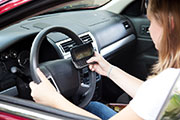
MONDAY, June 29, 2015 (HealthDay News) — Adding decals to the license plates of drivers with learner permits doesn’t reduce their rate of crashes, a new study finds.
The experimental safety strategy was implemented in New Jersey in 2010 as part of its graduated driver-licensing policy for drivers under 21.
Red reflective decals were placed on the license plates of drivers with learner permits or intermediate licenses. The decals are intended to make other drivers and police aware that a novice driver is behind the wheel.
Using information compiled in New Jersey’s driver-licensing database and police-reported crash database, researchers estimated the monthly rate of incidents for every under-21 driver with a permit from January 2006 to June 2012.
After taking age, gender, gas price and the month into account, the researchers determined that the decal program did not alter crash rates among drivers with learner permits. Nor did it affect the rate of citations for violation of the state’s graduated driver-licensing policy.
Authors of the study, published online June 29 in Injury Prevention, included Dr. Allison Curry of the U.S. Center for Injury Research and Prevention.
The researchers theorized that drivers with learner permits already comply with passenger and night-time restrictions, and they said crash rates among these adult-supervised drivers are already low. As a result, they said, there is little room for improvement so the initiative didn’t appear to have a significant effect.
They noted, however, that using the decals could potentially boost compliance with traffic safety laws.
Several other states have or are considering similar decal provisions, the researchers said.
More information
The U.S. Centers for Disease Control and Prevention provides more information on motor vehicle safety.
Copyright © 2024 HealthDay. All rights reserved.

